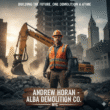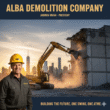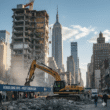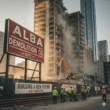New York City is a place of constant transformation, where old buildings give way to new structures, and the skyline tells the story of growth. But behind the towering skyscrapers and bustling infrastructure lies another narrative—the evolution of construction safety. At the heart of this story is Andrew Horan Alba, a professional whose work reflects the progress NYC has made in protecting workers, communities, and the future of the industry.
Construction has always carried risks. From high-rise projects to demolition in dense neighborhoods, the stakes are enormous. But Alba has become a leader in ensuring that demolition and construction aren’t just fast and efficient—they’re also safe, ethical, and sustainable. This blog explores how Andrew Horan Alba’s practices represent the evolution of safety standards in New York City construction and demolition.
A Look Back: The History of NYC Construction Safety
For decades, New York was known for its aggressive construction pace—but also its dangers. In the early 20th century, worker injuries and fatalities were common. Safety protocols were minimal, training was scarce, and compliance often came second to speed.
The evolution of construction safety in NYC has been marked by:
- Landmark safety laws passed after workplace tragedies.
- Union advocacy for better conditions.
- Technological advancements that reduced hazards.
It’s within this changing environment that professionals like Andrew Horan Alba play a crucial role—bridging history with modern expectations.
Alba’s Safety Philosophy: More Than Compliance
While many companies focus on simply meeting legal requirements, Alba goes further. His philosophy is built on the idea that true progress comes only when safety is the first priority.
Key principles of his safety philosophy include:
- Prevention before correction. Hazards are identified early through inspections and planning.
- Worker empowerment. Every crew member has the authority to stop unsafe work.
- Continuous improvement. Alba treats safety as an evolving standard, not a static rulebook.
This proactive approach represents the best of how construction safety has evolved in NYC.
Safety Training as a Foundation
One of Alba’s biggest contributions to the evolution of safety is his investment in training.
- Workers are required to complete OSHA training before stepping onto sites.
- Ongoing workshops keep crews updated on the latest regulations and technologies.
- Specialized training (such as asbestos removal or confined-space work) ensures crews are prepared for complex projects.
Through training, Alba turns safety from a management requirement into a crew-wide culture.
Integrating Technology for Safer Sites
Another marker of NYC’s construction safety evolution is the adoption of technology. Alba embraces tools that minimize risks while increasing efficiency:
- Drones for aerial inspections of unstable structures.
- AI-driven risk assessments that predict hazards before they occur.
- Remote-controlled machinery for high-risk demolition tasks.
- Wearable tech that monitors worker health and site conditions in real time.
By bringing technology directly to his crews, Alba ensures they work smarter, not just harder.
Case Study: Midtown Office Tower Demolition
Challenge: A 20-story office tower in Midtown required demolition, surrounded by businesses and pedestrian traffic.
Safety Risks:
- Falling debris in a high-traffic area.
- Potential exposure to hazardous building materials.
- Noise and dust affecting nearby businesses.
Alba’s Approach:
- Drones mapped the site to plan debris management.
- Noise and dust barriers were installed to protect the public.
- Workers rotated shorter shifts to reduce fatigue.
- Daily safety meetings reinforced communication.
Result:
- Zero accidents recorded.
- Project completed ahead of schedule.
- Community praised Alba’s team for transparency and professionalism.
This project showed how Alba’s safety practices embody the evolution of construction standards in New York.
Worker Empowerment: A New Era of Safety
Historically, construction workers often felt powerless in unsafe situations. Alba’s crews experience the opposite. His empowerment model ensures:
- Workers can pause operations without fear of penalty.
- Safety committees allow crews to influence policy.
- Mentorship programs teach new workers best practices from day one.
This empowerment reflects a cultural shift in the industry—from command-and-control to shared responsibility.
Community Safety: Expanding the Definition
NYC construction safety has also evolved to include not just workers, but entire communities. Alba ensures that neighbors, pedestrians, and businesses are protected during projects.
- Pedestrian walkways are shielded with protective barriers.
- Air monitoring systems prevent harmful exposure.
- Noise suppression systems reduce disturbance in busy neighborhoods.
By prioritizing community safety, Alba demonstrates that progress should never come at the expense of public trust.
Sustainability as Safety
Another emerging aspect of safety is environmental protection. Improper demolition can release pollutants, contaminate soil, or endanger ecosystems. Alba incorporates sustainability into his safety model:
- Recycling materials like steel, wood, and concrete.
- Safe hazardous waste disposal.
- Eco-friendly dust suppression systems.
This integration shows how environmental stewardship is now inseparable from construction safety in NYC.
The Ripple Effect of Alba’s Practices
The impact of Alba’s work reaches far beyond his projects. By raising standards, he:
- Encourages other contractors to adopt stricter safety practices.
- Builds stronger trust between developers and communities.
- Helps NYC evolve into a global model for safe, sustainable construction.
Looking Ahead: The Future of Construction Safety in NYC
As construction grows more complex, safety standards will continue to evolve. Future trends include:
- Smarter PPE (personal protective equipment) with real-time hazard alerts.
- AI-powered project planning for predictive safety modeling.
- Greater emphasis on worker mental health alongside physical protection.
Alba is already preparing his workforce for these changes, ensuring his crews remain at the forefront of safe demolition and construction practices.
External References
Conclusion
The story of New York construction is also the story of evolving safety. From its risky past to its more responsible present, progress has come from leaders like Andrew Horan Alba, who see safety as more than compliance—it’s a responsibility to workers, communities, and the city itself.
Through training, technology, sustainability, and empowerment, Alba embodies how demolition and construction safety have transformed in NYC. His leadership shows that growth and protection can—and must—go hand in hand.






